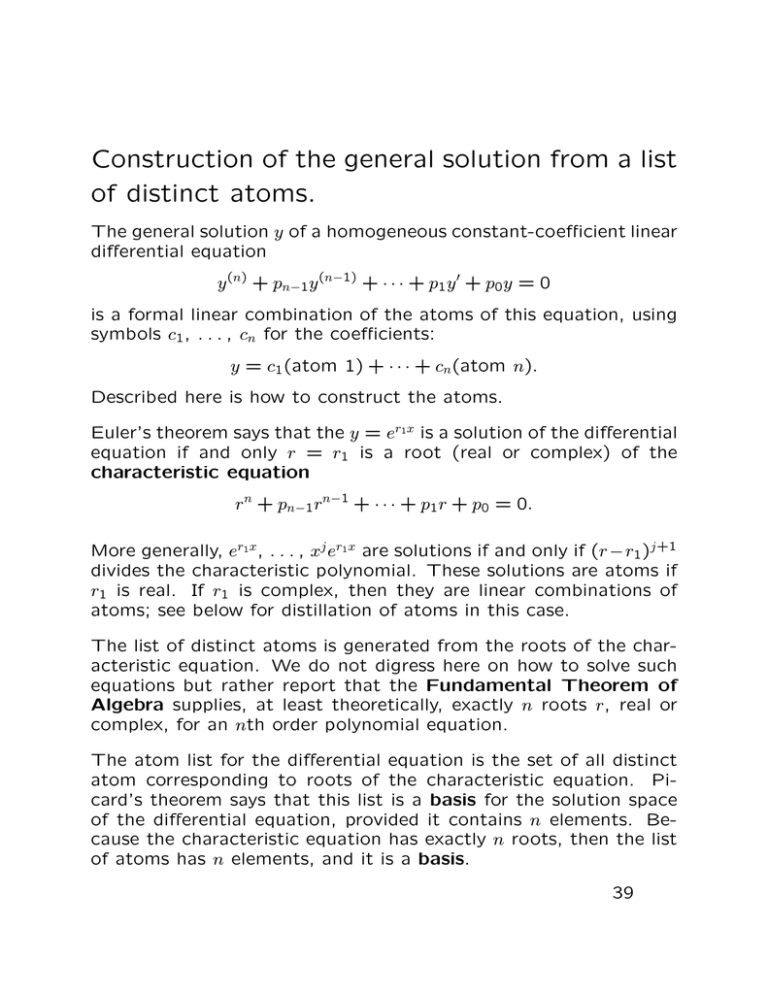Construction of the general solution from a list of distinct atoms.
advertisement

Construction of the general solution from a list of distinct atoms. The general solution y of a homogeneous constant-coefficient linear differential equation y (n) + pn−1y (n−1) + · · · + p1 y ′ + p0 y = 0 is a formal linear combination of the atoms of this equation, using symbols c1 , . . . , cn for the coefficients: y = c1 (atom 1) + · · · + cn (atom n). Described here is how to construct the atoms. Euler’s theorem says that the y = er1x is a solution of the differential equation if and only r = r1 is a root (real or complex) of the characteristic equation rn + pn−1 rn−1 + · · · + p1 r + p0 = 0. More generally, er1 x, . . . , xj er1 x are solutions if and only if (r −r1 )j+1 divides the characteristic polynomial. These solutions are atoms if r1 is real. If r1 is complex, then they are linear combinations of atoms; see below for distillation of atoms in this case. The list of distinct atoms is generated from the roots of the characteristic equation. We do not digress here on how to solve such equations but rather report that the Fundamental Theorem of Algebra supplies, at least theoretically, exactly n roots r, real or complex, for an nth order polynomial equation. The atom list for the differential equation is the set of all distinct atom corresponding to roots of the characteristic equation. Picard’s theorem says that this list is a basis for the solution space of the differential equation, provided it contains n elements. Because the characteristic equation has exactly n roots, then the list of atoms has n elements, and it is a basis. 39 Euler’s Theorem. The function y = xj er1x is a solution of a constant-coefficient linear homogeneous differential of the nth order if and only if (r − r1)j+1 divides the characteristic polynomial. The atom list for either a real root or a complex root is generated as follows. 1. If r1 is a real root, then the atom list for r1 begins with er1 x . The revised atom list is er1 x , xer1x , . . . , xk−1 er1x provided r1 is a root of multiplicity k, that is, (r − r1 )k divides the characteristic polynomial, but (r − r1 )k+1 does not. 2. If r1 = α + iβ, with β > 0, is a complex root along with its conjugate root r2 = α − iβ, then the atom list for this pair of roots (both r1 and r2 counted) begins with eαx cos βx, eαx sin βx. If the roots have multiplicity k, then the list of 2k atoms are eαx cos βx, eαx sin βx, xeαx cos βx, xeαx sin βx, ..., ..., xk−1 eαx cos βx, xk−1 eαx sin βx. 40 Explanation of steps 1 and 2. In step 1, root r1 always produces atom er1x, but if the multiplicity is k > 1, then er1x is multiplied by 1, x, . . . , xk−1. In step 2, the expected first terms er1x and er2x [eαx+iβx and eαx−iβx] are not atoms, but they are linear combinations of atoms: eαx±iβx = eαx cos βx ± ieαx sin βx. The atom list for a complex conjugate pair of roots r1 = α + iβ, r2 = α − iβ is obtained by multiplying the two real atoms eαx cos βx, eαx sin βx by the powers 1, x, . . . , xk−1 to obtain the 2k distinct real atoms in item 2 above. 41





